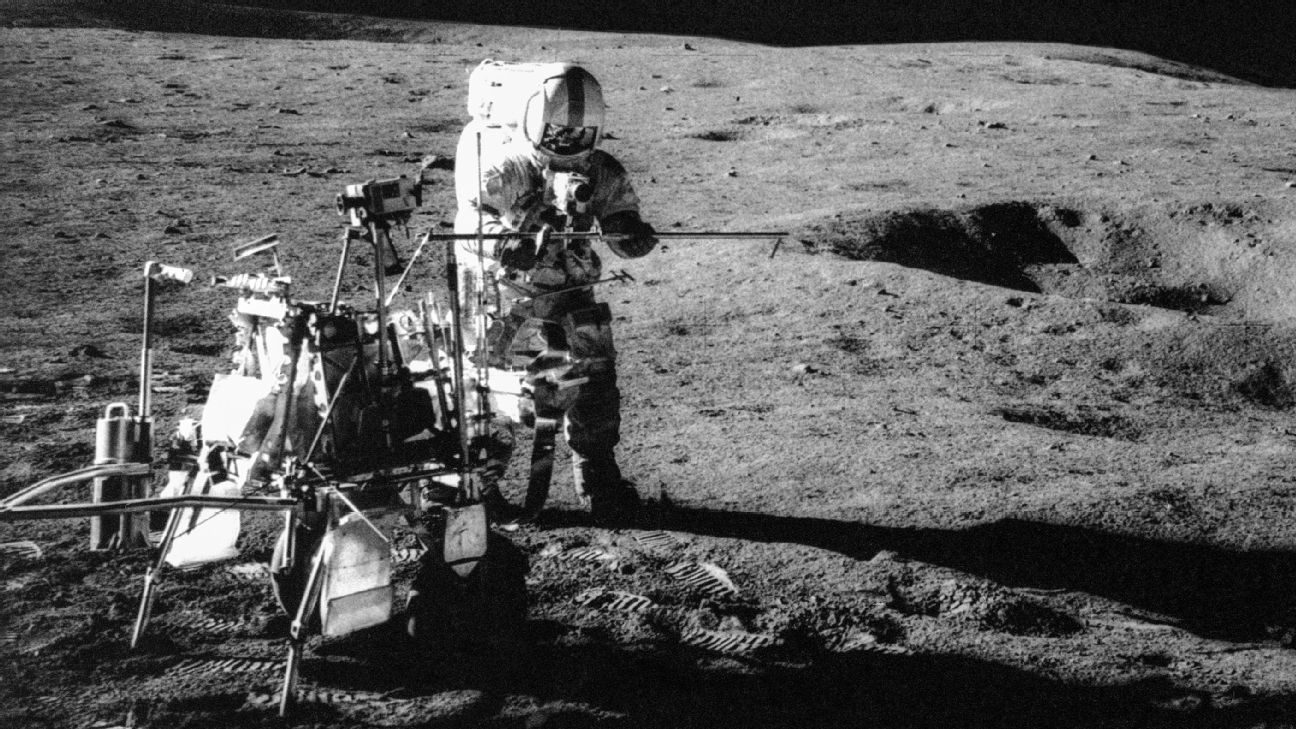We’ve all misplaced something — car keys, wallets, a W-2 from last year.
But what about misplacing something worth millions that has incredible historical significance? Well, welcome to one of the stranger corners of the booming sports memorabilia market.
Whether it’s misfortune, the tide of time or just dumb luck, some of the most prized — ergo, valuable — sports memorabilia items of all time aren’t in halls of fame or museums. They’re missing.
Here are six holy-grail-level sports memorabilia items that are lost to history — for now — and what they would be worth today.
The chip shots seen around the world
Fifty years ago, Alan Shepard hit the two of the most-watched golf shots ever on the surface of the moon. The golf balls are still there. In February, Andy Saunders, an image specialist and author of an upcoming book Apollo Remastered, used still photographs taken by the astronauts on Feb. 6, 1971, and spotted the two balls. One is 40 yards away from where Shepard swung a makeshift 6-iron club that he sneaked onto Apollo 14 without NASA’s knowledge and the other is 24 yards away.
Shepard’s club is in the USGA Golf Museum. NASA officials were upset about the donation and actually tried to get the club back because officials believed that it technically wasn’t his property to give. Getting the balls back would be “the billionaire’s scavenger hunt,” said Bob Zafian of Golden Age Golf Auction.
Zafian estimates the Shepard club could go for $10 million and he believes the golf balls would start at a minimum bid of $10 million apiece.
“This is something that nobody else can have,” Zafian said. “Absolutely, without a doubt, the most expensive golf item that is in existence that possibly could be there for the taking if somebody picks it up.”
Where is Jackie Robinson’s first Dodgers jersey?
On April 15, 1947, Jackie Robinson made his MLB debut at Ebbets Field in Brooklyn, New York. When Robinson stepped to the plate that day, he became the first Black player in MLB history, thus paving the way for decades to come. But the jersey he wore in front of 26,000-plus people is missing.
A jersey from later in Robinson’s rookie season was sold for $2.05 million at an auction in 2017.
Chris Ivy, director of sports auctions at Heritage Auctions, said the missing jersey, if in decent condition and authenticated, would go for no less than $10 million.
“I think a good argument could be made that it’s the most significant … piece of sports memorabilia that could be offered,” Ivy told ESPN. “[You] can’t argue with the significance of the jersey that was on Jackie Robinson’s back when he literally broke the color barrier in baseball.”
Bobby Thomson’s ‘Shot Heard ‘Round the World’? Long gone
Bobby Thomson’s 1951 home run remains one of the most famous walk-offs in MLB history. His bat, glove and the cleats reside in Cooperstown, but arguably baseball’s most hallowed piece of rawhide went the way of Jimmy Hoffa.
Dozens of fans claimed to have the ball in the days after Thomson’s homer, and one even conned World Series tickets out of Thomson in exchange for what he thought was the actual ball. It wasn’t.
Years later, one ball was unearthed that was believed to be the Thomson home run ball before many experts ultimately decided it was unlikely to be the ball of note. Mike Heffner, a partner at Lelands sports auction house, has a history with Thomson’s ball.
“We scoured New York, ran a $1 million wanted ad,” Heffner said. “But say you had video footage, the person catching the ball, a sworn affidavit, the ball matched up? It could be a million-dollar ball, the way things are going.”
Leila Dunbar, the former director of collectables at Sotheby’s and an Antiques Roadshow mainstay, loves the history behind the ball. She hails Miracle Ball — a Brian Biegel book about his two-year manhunt for the Thomson home run ball, which his father once falsely claimed to own — as keeping interest and intrigue about the Thomson ball going. That includes an epic tale about a nun who allegedly had it at one time.
Dunbar dismissed the story.
“This nun played hooky, caught the ball and when she died? Her family put it in a box and dumped it off a highway,” Dunbar said of the absurdity.
Dunbar, though, said the ball still has value.
“I’m not sure it has the resonance to collectors as it did 10 years ago, [but] if the Buckner ball sells for almost half a million? This should sell for at least half a million.”
The Kirk Gibson home run ball? Also missing
In the bottom of the ninth in Game 1 of the 1988 World Series, Kirk Gibson looked more likely to collapse in the batter’s box than craft a timeless Los Angeles sports moment — especially against A’s closer Dennis Eckersley, who hadn’t allowed a home run since late August. Then, as Vin Scully famously crooned, The impossible has happened.
In 2018, Eckersley’s jersey from the game fetched a little more than $60,000. Gibson’s bat, jersey and helmet pulled in $1.03 million at auction in 2010. But where’s the ball? No one knows. The seat where it landed is known: Row D, Seat 88, Section 302. Gibson even signed it. A woman once sent Gibson a picture of her bruised leg where the home run supposedly had landed.
“It may never be [found],” Gibson told the New York Times in 2018. But if it were? “It’s a better piece than the Thomson [ball] for my generation,” said Heffner, who was a 20-something Dodgers fan in 1988. “Based on [the previous sale], that the market’s so hot, that people spending money in this industry are [from] L.A.? Could be a $2 million ball.”
Added Dunbar: “I could definitely see it selling for a million in today’s market because of what it represented. It didn’t win the series, but it changed the whole tenor, and [the Dodgers] were heavy underdogs.”
There’s one person sure to empty his bank accounts should it ever surface. At that 2010 auction, father-and-son sports collectible team Chad and Doug Dreier spent $1.19 million on various Gibson memorabilia, including his MVP Award and World Series trophy.
Though Chad Dreier died in late 2018 after a battle with cancer, the Dreier Collection, sold in 2011, included the Gibson items — except for the iconic ball.
‘Shoeless’ Joe Jackson’s stolen confession hasn’t been found — if it ever even existed
The late Joshua Leland Evans, the founder of Lelands, famously offered multiple rewards for anyone who could procure the most infamous confession in sports: Shoeless Joe Jackson, admitting to taking money to throw the 1919 World Series.
“I don’t think it exists,” Heffner said. “But Josh, in the ’80s, put out a bounty for like $100,000 ahead of the release of Eight Men Out.”
In 2013, Evans upped the award to $1 million despite widespread doubt in the industry about the document.
“There’s a huge cloud of mystery behind it,” Dunbar said. “Many historians have said it doesn’t exist.”
Dramatized in Eight Men Out, Jackson testified in front of a grand jury, giving contradictory statements about his involvement with the 1919 Black Sox scandal. The transcript was included in a signed confession.
It soon vanished (rumor has it thanks to chicanery by Charles A. Comiskey and Arnold Rothstein) and the lack of concrete evidence was paramount to why the Black Sox weren’t found guilty of fraud in court. The confession, purportedly, only resurfaced to damage Jackson’s chances of returning to baseball. Then, the actual physical document disappeared again.
The problem is the confession story has run haywire, according to the Society for American Baseball Research. The transcripts of Jackson and pitchers Eddie Cicotte and Lefty Williams were stolen, but they were recreated with stenographers’ trial notes.
Detailed in the 1995 book The Fix Is In, Jackson recanted his testimony and claimed any confession was penned by his lawyer in the case, Alfred Austrian, also Comiskey’s lawyer, who somehow uncovered Jackson’s misplaced transcript years later to thwart his bid to return to baseball.
Jackson could never seem to keep his story straight. Sometimes, he was on record as having taken a $5,000 bribe (at the urging of White Sox brass). Sometimes, it was $10,000.
But he always maintained he never physically threw the Series or played less than his hardest, vehemently defending his “innocence” until his passing in 1951.
Jackson also said he was essentially illiterate, that he couldn’t have written anything. An authenticated signature from Jackson is among the rarest in sports history — he said his wife signed everything for him.
“Just his signature on a slip of paper is worth $50,000 to $100,000,” Heffner said, recalling the signed photo that went for $180,000 at an auction in 2015, the only known signed photo by Jackson in existence. “The confession would be one of the most valuable pieces in baseball history.”
“If it exists,” Dunbar said. “Because of what it represents as a pivotal moment in baseball history, it could sell anywhere from a half a million to a million dollars.”
Or maybe more if the right buyer was found.
“If someone actually had that thing?” Heffner said. “My God, I would pay $3 million for it.”
The mystery of the Wilt Chamberlain 100-point ball
In April 2000, when Kerry Ryman sold Wilt Chamberlain’s 100-point ball for more than $550,000 at an auction, it caused quite a stir. It was the world’s most expensive basketball and one of the loftiest sports tokens ever sold.
And then… the sale was nullified a month later over questions of authenticity.
Here are the facts: On March 2, 1962, in Hershey, Pennsylvania, Chamberlain scored 100 of the Philadelphia Warriors’ 169 points in a win over the Knicks. After the game, Ryman, who was a teenager, stole a ball, dashed out of the arena, evaded a security guard and jumped a fence. Chamberlain watched it all happen and told a security guard to let him go.
But there’s debate about which ball Ryman grabbed. The game’s scorekeeper, longtime Warriors PR director Harvey Pollack, who scribbled the famous “100” sign that Chamberlain holds in the postgame photo, said that the ball of note was taken out of the game, given to Chamberlain, signed by Chamberlain and teammates, and displayed in the team’s offices.
If that’s the truth, though, the Warriors seem to have lost it in the move from Pennsylvania to San Francisco. No one appears to know what happened to one of the NBA’s most prized artifacts after the relocation.
Ryman’s ball was sold later that year for roughly $68,000. Lelands’ Evans, who passed away in December, remained resolute that it was the 100-point ball.
Dunbar, the manager of Chamberlain’s estate, tracked down Wilt’s shoes from that night, which sold for $52,000. A signed scorecard from that night fetched $215,000.
And if the ball ever reappears and is somehow able to be verified? It could be worth more than $500,000.
“Could be more, because of what it represents and the player,” Dunbar said. “No one’s broken the 100-point game record and I’m not sure anyone ever will.”

